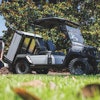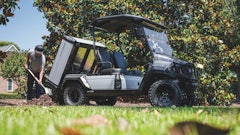
Most landscape contractors are generating the majority of their revenue between the months of April and October. Some have longer seasons, of course, while others transition to snow removal during the winter. Regardless, when spring springs and your lawn care and/or landscaping hat comes out, it's time to rock and roll.
What happens during your "spring training season" depends on a lot of factors, such as where you're located and the size of your company. Your service/client mix will also likely come into play.
For example, Bumgardners Landscape in Medford, OR, is primarily a commercial maintenance company. Thus, unlike the typical lawn care company, for instance, they aren't tasked with a frantic pre-season sales push to get business on the books. "We are constantly in contact with our customers throughout the year, often selling new work like enhancements and irrigation repairs," says second-generation co-owner Bill Bumgardner. "We also have the majority of our renewals and new contracts locked in by November."
Lawn care and residential-focused contractors typically have it a little different. Take Ken Hennebert of KLC Lawn & Landscape in Maryville, TN, for example. "I start focusing on going back to my customers in mid- to late-January to discuss their budgets for the year, along with any projects they might have in mind," Hennebert says. "I also start re-mulching beds and doing other cleanup-type work."
Anne Campbell of Colorado Stoneworks Landscaping in Colorado Springs has it a bit both ways. The company has over 900 single-family residences it maintains for property managers. Those are renewed in the fall. But the company also has a lawn care division. "We're pushing hard right away in January because our first application is at the end of February," Campbell says. "But other than that, we don't sell too hard. Our website generates most of our leads now."
Also in Colorado, Bill Chevalier, co-owner of Environmental Landworks in the Denver area, has to chuckle when he hears the term off-season. "We use that term a lot, but in reality, it doesn't even exist for us," Chevalier says. First of all, this construction-focused company has established a substantial snow removal operation over the past few years. Secondly, weather patterns fluctuate wildly in the Centennial State. "We always have a pretty good backlog of construction work," adds partner Michael Sittaro. "We sometimes get a few 60° days in December. So we make sure we can switch over quickly from snow removal to construction if the opportunity presents itself."
Environmental Landworks, and other successful companies like it, are able to do that for three primary reasons: the consistency of its people, the reliability of its equipment, and the precision of its work processes.
The People Factor
Many landscape companies face the challenge of having to find numerous seasonal employees during the first few months of the year. Environmental Landworks tries to avoid this as much as possible.
"We don't like to drop any field employees when we transition from summer to winter," Sittaro points out. "We just move people around and share hours." Several employees obviously shift over to snow removal. But additionally, for example, the residential construction department—which stays pretty active through winter—might get a few maintenance technicians during the winter months. "So we really have to focus on cross training," Sittaro says.
"Even if some of our guys are only getting 10 or 15 hours a week during the winter, we want to keep them on," Chevalier adds. "Having your core team in place year after year makes a difference. We don't have to undergo that mass training effort a lot of companies have to do early in the season."
Over in Oregon, Bumgardner agrees with this philosophy. Bumgardners Landscape generally runs seven year-round employees along with a couple of seasonal employees. "I hold my crews as tight as I can to keep the really good guys on," Bumgardner says. "This cuts back on our training needs and improves safety."
That said, safety is still a big deal. Bumgardners has begun utilizing some online training called LS Training. Each year prior to March, all crew members must pass the training in order to renew their certification.
For the couple of new employees he's generally looking for each spring, Bumgardner relies on existing employee referrals and other contacts in the community. Craigslist has also proven somewhat effective. "It's never easy, though," Bumgardner reminds. "So even when we aren't hiring, we're looking. You can't wait until things get really busy; that's when you make poor hiring choices."
Craig den Hartog, owner of Emerald Magic Lawn Care in Holtsville, NY, could not agree more. "Finding really good talent is a year-round search. I look for a good attitude and work ethic. I'd rather hire a new-to-the-field sponge than a know-it-all stone. Winter is definitely the time to then make your moves and replace the weaknesses on your team."
The Equipment Factor
Winter is obviously a good time to upgrade equipment too. Much like the search for new employees, this process should also start well in advance of your pre-season.
"We do an end-of-year review where I look at each piece of equipment's service history to determine if a major overhaul is needed or just routine preventive maintenance," den Hartog tells. If something needs to be replaced, it goes on his wish list. "Major purchases are made in early spring, since I like to wait and see what the various suppliers are offering for rebates and financing."
Bumgardner and Campbell have also implemented end-of-year equipment audits. "We do our basic end-of-year maintenance like draining gas out of equipment," Campbell says. "We stop using equipment in November," adds Bumgardner. "That's when we clean it up and check things over, but we actually like to leave some fuel in. So we add fuel stabilizer and grease things up. Then our equipment is in a ready-to-go state come spring. We'll still check things over one more time at the start of the season. We don't have an on-staff mechanic. But two of my foremen are really good with equipment and get it dialed in. It's also their responsibility to stay on top of maintenance needs, so we make sure the owner's manuals are accessible."
With respect to his trucks, Bumgardner leans a bit heavier on a vendor partner. "I have an auto shop handle all of our service needs. He uses a software program that tracks our entire fleet. The neat thing is that I have access to view the dashboard. If something should be done at 60,000 miles, for example, we get it in. The software sends out notifications when something is coming due, but I also keep an eye on that dashboard."
The Environmental Landworks owners also rely heavily on vendor partners to manage their fleet—but in this case we're talking about construction equipment. "We do a lot of leasing," Chevalier says. "We also use a lot of our construction equipment for snow removal. We never have a time where 12 skid steers are parked in our yard. So we're staying on top of service issues throughout the year. We keep a list of what's new, old, and what's used the most and should turn over. We then balance those needs against our budget."
Since construction equipment is shared across departments and crews, foremen are responsible for inspecting the equipment each time they use it. They fill out a maintenance sheet and turn it into their manager. "Any red flags then come to me," Sittaro says.
This is where vendor relationships come into play. "We lease our larger construction equipment like skid steers for four years," Sittaro says. "We also have maintenance agreements with the dealers. They'll send a service technician to us every few months."
"Mike (Sittaro) has done a great job building relationships with our vendors," Chevalier adds. "No matter how hard you prepare, something will eventually go down. Because of the relationships Mike has built, our dealers will come and get a skid steer if it goes down, dropping off another one we can use until ours is fixed. These relationships need to be nurtured, and the winter months are a great time to focus on that."
The Work Process Factor
Part of any good pre-season regiment for a landscape company is to re-evaluate work processes to try and identify ways of being more efficient. Again, this should be happening throughout the year, but the month or two before the season starts is an ideal time to sit everyone down and implement changes as necessary.
"We use our entire off-season to conduct a post-mortem on the previous year," Campbell says. "We're looking for ways to get better. We're still a small enough company (18 employees) that everybody can be involved. That's important, because the people working out in the field are the ones who know how we can get better. If they aren't happy with how we're doing things, things probably aren't going to go well."
"I talk with my two account managers almost daily, but we formally sit down once a month to talk about how we can work smarter, not harder, in the field," Bumgardner shares. "So we're constantly looking for feedback from all of our employees. I always ask 'why' so I can really learn from them and come up with better processes."
"We meet with our supervisors constantly, and conduct all employee performance reviews by the end of the year," Sittaro says. "Then, after budgeting, we meet as a management team in February to come up with goals for the coming year. Then we start meeting with individual teams to get their ideas. Everyone is providing input." Once departmental goals are set, everyone has to sign a pledge of sorts saying that they're on board.
And once everybody is on board, spring is welcome to spring—whenever that might be.


![Gravely Pro Turn Mach One My23 Dsc03139 Edit 1200x800 5b2df79[1]](https://img.greenindustrypros.com/mindful/acbm/workspaces/default/uploads/2025/10/gravely-pro-turn-mach-one-my23-dsc03139-edit-1200x800-5b2df791.BucBnDoN22.jpg?auto=format%2Ccompress&fit=crop&h=100&q=70&w=100)








![Gravely Pro Turn Mach One My23 Dsc03139 Edit 1200x800 5b2df79[1]](https://img.greenindustrypros.com/mindful/acbm/workspaces/default/uploads/2025/10/gravely-pro-turn-mach-one-my23-dsc03139-edit-1200x800-5b2df791.BucBnDoN22.jpg?ar=16%3A9&auto=format%2Ccompress&fit=crop&h=135&q=70&w=240)









